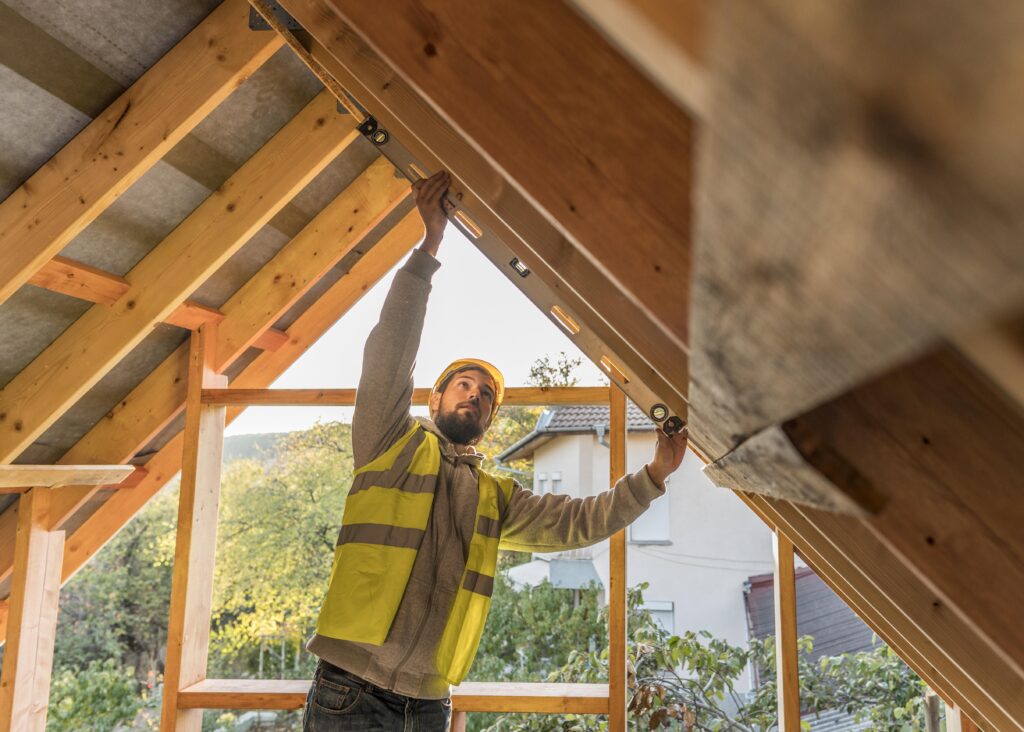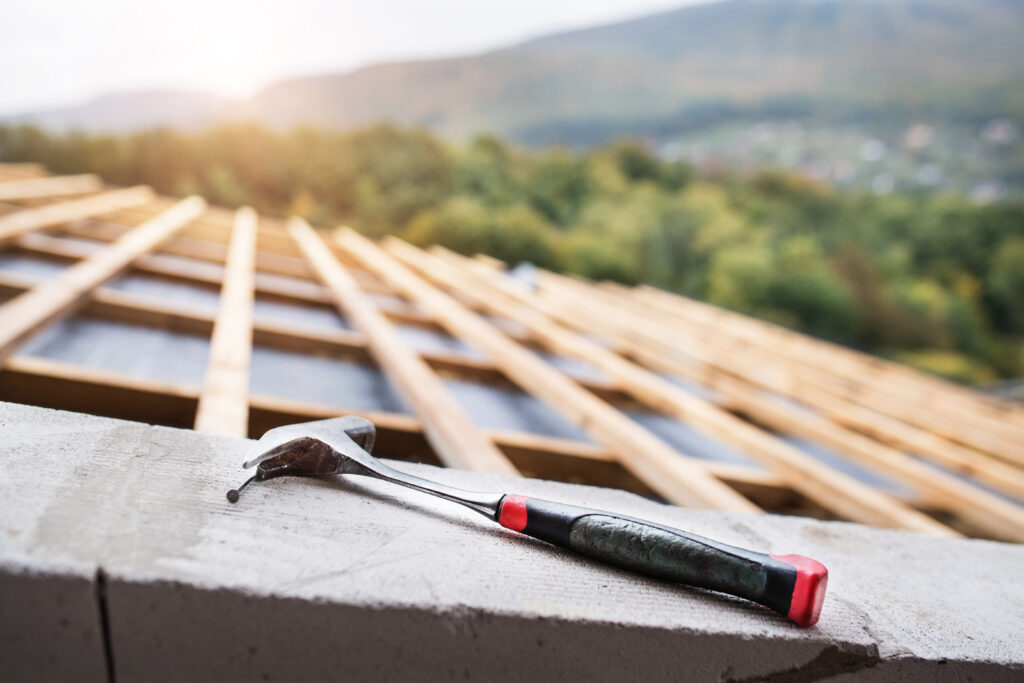Your roof’s performance and longevity depend significantly on selecting the right roofing underlayment types. Underlayment acts as a vital second line of defense that protects your home against rain, wind, snow, ice, and even fire. Building codes mandate underlayment installation because it effectively repels water.
Roofing materials use three simple types of underlayment: asphalt-saturated felt, rubberized asphalt, and non-bitumen synthetic. Each type brings unique benefits based on specific needs. To cite an instance, felt underlayment comes in 15-pound and 30-pound thicknesses and resists water but isn’t waterproof. Rubberized asphalt underlayment works best in areas that face heavy rain or ice dams. Synthetic underlayments provide a lightweight, durable option that resists tearing and UV rays.
This piece explores roofing underlayment’s different types, characteristics, and installation methods. You’ll learn how to select the right option based on your climate and roofing material. The guide also covers why underlayment failures happen and includes expert recommendations to help you make smart choices for your roofing project.

Understanding the Three Main Roof Underlayment Types
Choosing the right underlayment materials that match your needs is crucial to protect your roof. Let’s examine three main roofing underlayment types and their unique characteristics that will help you make the best choice.
Felt Underlayment: Organic vs Fiberglass Base
Felt underlayment ranks among the oldest solutions in the roofing industry. Manufacturers create it by saturating paper or fiberglass mat with asphalt to resist water. The two main types differ based on their foundation material. Organic felt comes from a cellulose base made of recycled paper or sawdust. Fiberglass-based felt uses inorganic materials instead. Both types serve the same purpose, but builders use organic-based felt more often.
No. 30 felt proves more durable than No. 15 felt, which makes it a better choice for steep-pitched roofs. But felt underlayment can wrinkle when it gets wet, and this might stop shingles from sitting flat.
Rubberized Asphalt: Self-Adhering and Self-Sealing
Rubberized asphalt underlayment combines asphalt with rubber polymers to create a superior waterproof barrier. This premium option features a sticky adhesive backing with removable release paper that sticks directly to your roof deck.
This material’s standout feature is its ability to seal itself around fasteners and nails. It stays waterproof even after penetration. High-temperature versions can handle heat up to 250°F without losing adhesive strength, which makes them perfect for metal roofs.
The material’s smooth surface helps create better lap adhesion and eliminates “fish mouth” leaks that other materials might develop. Multiple layers work together to form a protective membrane that guards your roof’s most vulnerable spots.
Synthetic Underlayment: Polypropylene and Polyethylene Variants
Synthetic underlayment represents the newest state-of-the-art option in roofing. It consists mainly of laminated polypropylene or polyethylene plastic materials. These engineered products are substantially more tear-resistant and durable than traditional options.
Synthetic underlayment weighs four times less than felt and covers much more area per roll. Installers make fewer trips up the ladder, which speeds up the installation process.
These synthetic options push water away instead of soaking it up like felt. They keep their shape without wrinkling. On top of that, they resist mold growth and can handle long-term UV exposure during construction delays.
Installation Guidelines Based on Roof Slope and Material
Roof pitch and materials determine the right installation procedures. Following the manufacturer’s guidelines will give optimal protection and keep warranty coverage intact.
Low-Slope Roofs: 19-Inch Overlap for Double Coverage
Low-slope roofs (2:12 to 4:12 pitch) need extra protection from water seepage. These roofs require a double-layer installation technique. The process starts with a 19-inch wide strip of underlayment that runs parallel to the eave. Next, 36-inch wide sheets go on top with 19-inch overlaps between successive sheets. This creates a double layer over the entire roof. Water runs off more slowly on these surfaces, so this overlapping method gives substantially better protection.
Steep-Slope Roofs: 2-Inch Overlap and Fastening
Roofs with 4:12 and steeper slopes don’t need as much overlap. Upper courses should overlap lower ones by at least 2 inches. Water runs off faster on steeper pitches, so this minimal overlap is enough for protection. In spite of that, end laps need at least 6 inches where rolls meet. Adjacent courses should have their end laps offset by 6 feet.
Edge Metal Laps: Eaves vs Rakes
Different edges need different treatments. Underlayment should overlap the edge metal at the eaves. This creates a waterproof barrier that stops moisture from seeping in at this vulnerable spot. The rakes (sloped edges) work differently – underlayment goes down first, then edge metal overlaps it. This setup creates a watershed effect that guides water away from the roof deck.
Fastening Methods: Staples vs Plastic Caps
The time before final roofing installation determines fastener choice. Standard staples work well for same-day shingle installation. Plastic cap nails or cap staples offer better holding power when underlayment stays exposed longer. These caps spread pressure evenly and resist wind uplift better than regular staples. Most jobs need 6-inch spacing at overlaps and 12-inch spacing in field areas. High-wind zones require closer spacing between fasteners.

Common Causes of Underlayment Failure
Roof damage and expensive repairs often result from failed underlayment. Quality materials can break down too early under certain conditions.
Substandard Felt: ASTM Compliance Issues
Quality issues affect many felt underlayments available today. Products labeled as “underlayment” or “15-lb.” fail to meet ASTM standards, which results in materials that don’t have enough saturation. These non-compliant products soak up water easily and fail prematurely. Water absorption makes the product expand and wrinkle, showing through thinner asphalt shingles. The underlayment’s quality must meet ASTM D226 and ASTM D4869 specifications to protect the roof deck from water damage.
UV Exposure and Volatile Loss in Asphalt
Asphalt-based underlayment’s volatile compounds evaporate steadily, especially when you have heat exposure. The underlayment becomes fragile and absorbs moisture as these compounds disappear. All underlayment types deteriorate at different speeds under prolonged UV exposure. UV rays make synthetic underlayments brittle and release Volatile Organic Compounds (VOCs). Asphalt felt breaks down quickly under UV radiation, so installers need to cover it right after installation.
Improper Installation and Foot Traffic Damage
Poor workmanship stands out as one of the main reasons underlayments fail early. Careless handling during installation tears, wrinkles, or completely ruins delicate underlayment materials. Heavy foot traffic wears down residential roofs significantly. The roof’s protective layers weaken as pressure creates cracked or broken shingles and tiles over time. Movement near valleys and edges can disturb waterproofing layers and increase the risk of water getting in.
Wicking and Moisture Traps in Synthetic Underlayment
Synthetic underlayments offer benefits but come with their own challenges. The National Roofing Contractors Association reports that synthetic products’ wicking problems exceed those of felt underlayment. Moisture issues develop when installers use felt-appropriate techniques instead of following the manufacturer’s specific instructions. Synthetic underlayment acts as a vapor barrier that can trap moisture without proper ventilation, which leads to mold and wood rot.
Choosing the Right Underlayment for Your Roof
Picking the right roof underlayment needs you to think about several factors that will protect your home. Let’s look at what helps make this decision easier.
Climate Suitability: Hot, Cold, and Wet Conditions
Your local environment plays a big role in choosing the best underlayment. Synthetic underlayments work great in hot, arid climates like Arizona because they resist heat and UV rays better. Rubberized asphalt makes the best choice for cold and snowy regions. It stays flexible as temperatures change and creates waterproof barriers against ice dams. Waterproof underlayments become crucial in areas with heavy rainfall to stop moisture damage.
Roofing Material Compatibility: Shingles, Metal, Cedar
Each roofing material needs specific underlayment features. Most underlayment types work well with asphalt shingles, though synthetics give you the best results. Metal roofs need underlayments that can handle high temperatures—some products work up to 265°F—and stop condensation. Cedar shakes need space underneath for trapped moisture to escape. The best setup uses a vapor-permeable membrane with a ventilation mat.
Cost vs Performance: Felt vs Synthetic vs Rubberized
Felt underlayment costs the least but doesn’t last as long. Synthetic products hit the sweet spot between price and quality. They resist tears well, protect against UV rays, and repel moisture. Rubberized asphalt costs the most but gives you the best waterproofing and seals itself around fasteners.
Building Code and Warranty Considerations
Building codes say you must use underlayment in your roofing system. The International Residential Code requires underlayment materials that meet specific ASTM standards (D226, D1970, D4869, or D6757). Shingle manufacturers often make proper underlayment installation a must for warranty coverage. High-wind areas might need special installation methods or self-adhering membranes across the entire roof.
Conclusion
Your roofing project’s success depends heavily on picking the right underlayment. This piece breaks down three main underlayment options that work best in different situations. Felt underlayment gives you a budget-friendly option with proven results over decades, though it doesn’t handle moisture well. Rubberized asphalt costs more but does a better job at waterproofing and seals itself around fasteners. The lightweight and tear-resistant synthetic underlayment provides extended UV protection when construction gets delayed.
The way you install your underlayment affects how well it works by a lot. You’ll need double coverage with 19-inch overlaps for low-slope roofs. Steeper roofs work fine with 2-inch overlaps. Plastic cap nails protect better than standard staples when the underlayment needs to be exposed longer.
Underlayment failures happen for several reasons. Materials that don’t meet ASTM standards soak up too much moisture. UV rays damage all types of underlayment, especially felt products. Poor installation and too much foot traffic can weaken your roof’s entire system.
Weather plays a big role in choosing your underlayment. Synthetic options work great in hot areas, while rubberized asphalt handles cold regions and ice dams better. Your roofing material’s needs matter too – metal roofs need heat-resistant underlayment, and cedar shakes need something breathable.
Building codes and manufacturer’s warranties should guide your final choice. These requirements keep your roof safe and protected under warranty if problems show up. Getting these details right will protect your investment and give you peace of mind during bad weather for years ahead.
FAQs
Q1. What are the main types of roofing underlayment? There are three primary types of roofing underlayment: felt (asphalt-saturated), rubberized asphalt, and synthetic (non-bitumen). Each type offers different benefits and is suitable for various roofing situations.
Q2. How does climate affect the choice of underlayment? Climate plays a crucial role in selecting underlayment. Synthetic underlayments work well in hot, arid climates due to their heat resistance. Rubberized asphalt is ideal for cold regions prone to ice dams, while waterproof underlayments are essential in areas with heavy rainfall.
Q3. Is synthetic underlayment better than felt? Synthetic underlayment is generally more durable, tear-resistant, and weather-resistant compared to felt. It’s also lighter and covers more area per roll. However, felt remains a cost-effective option with a long history of use in the roofing industry.
Q4. How should underlayment be installed on different roof slopes? For low-slope roofs (2:12 to 4:12 pitch), use a double-layer installation with 19-inch overlaps. On steeper slopes (4:12 and above), a 2-inch overlap is sufficient. Always follow manufacturer guidelines and local building codes for proper installation.
Q5. What factors can cause underlayment failure? Common causes of underlayment failure include using substandard materials that don’t meet ASTM standards, prolonged UV exposure, improper installation, excessive foot traffic during installation, and moisture issues. Choosing high-quality materials and ensuring proper installation can help prevent these problems.
